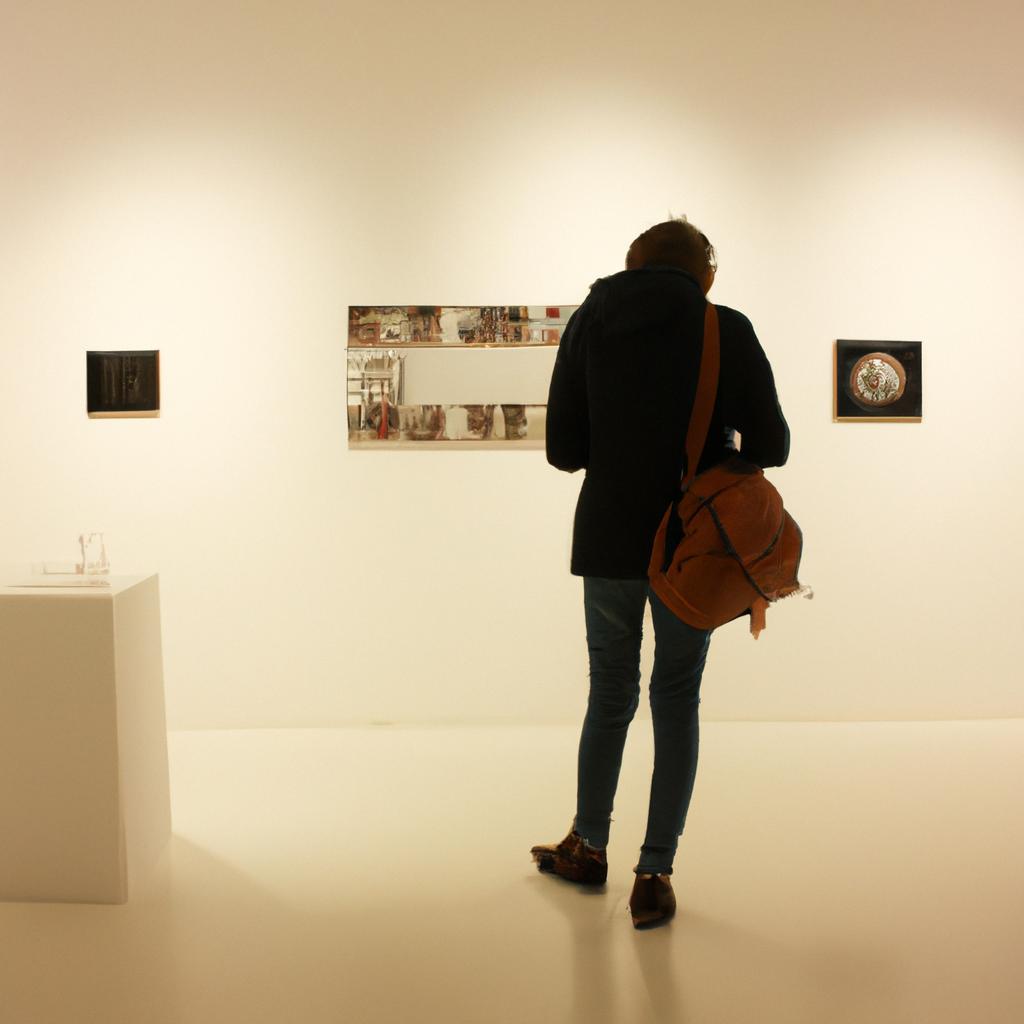Art Galleries: Discover the Beauty of Tourist Attractions in the Travel Directory

Art galleries have long been regarded as iconic tourist attractions, drawing visitors from all over the world to appreciate and explore the beauty of visual arts. These cultural institutions not only provide a platform for artists to showcase their works but also offer an enriching experience for tourists seeking to immerse themselves in the realm of aesthetics. One such example is the renowned Louvre Museum in Paris, which houses an extensive collection of masterpieces spanning centuries and continents.
In today’s globalized society, travel directories play a pivotal role in guiding individuals towards fulfilling journeys filled with memorable experiences. They serve as invaluable resources that curate information about various destinations worldwide, including art galleries. The presence of these meticulously curated catalogs ensures that travelers do not overlook the artistic treasures hidden within cities they visit. By featuring art galleries prominently in their listings, travel directories enable tourists to discover fascinating exhibits, witness diverse artistic expressions, and delve into the rich tapestry of culture present at each destination. Therefore, exploring art galleries through travel directories can prove to be a gateway to discovering captivating tourist attractions beyond conventional landmarks.
Exploring the Diversity of Art Galleries
Art galleries are captivating spaces that showcase a wide range of artistic expressions, offering visitors an opportunity to immerse themselves in the beauty and creativity of various art forms. These cultural institutions have become significant tourist attractions worldwide, drawing millions of patrons each year. By exploring the diversity of art galleries, one can embark on a journey through time and culture, discovering unique perspectives and narratives.
To illustrate this point, let us consider a hypothetical example: Imagine stepping into a contemporary art gallery nestled in the heart of a bustling city. As you enter, vibrant colors leap off the canvases, capturing your attention and igniting your curiosity. Paintings depicting social issues engage your emotions while sculptures made from unconventional materials challenge traditional notions of artistry. The experience is not only visually stimulating but also thought-provoking as it prompts contemplation about the world we live in today.
When visiting art galleries, tourists can expect to encounter an array of emotional responses evoked by their surroundings:
- Awe-inspiring masterpieces that leave viewers breathless
- Thought-provoking installations that stimulate reflection
- Intimate exhibitions that create personal connections with artwork
- Interactive displays that encourage active participation
Moreover, these emotional experiences are often enhanced by the architectural design and layout within the gallery space itself. For instance, imagine walking into a grand room filled with natural light pouring through large windows, casting ethereal shadows over delicate sculptures displayed atop pedestals. Such an ambiance creates an atmosphere where imagination flourishes and enchantment ensues.
In delving deeper into this exploration of art galleries’ diversity, it becomes evident that there is no one-size-fits-all approach when it comes to these creative havens. Each gallery offers its own distinct charm – be it historical artifacts exhibited in hallowed halls or avant-garde installations breaking boundaries in contemporary spaces. This rich tapestry allows visitors to tailor their experiences based on personal preferences and interests, ensuring that everyone can find solace or inspiration within the walls of these artistic sanctuaries.
Transitioning into the subsequent section about “Famous Art Galleries Worth Visiting,” one can see how this diversity manifests itself in various renowned institutions around the world. From iconic museums housing priceless masterpieces to hidden gems showcasing emerging artists, there is an art gallery out there waiting to captivate every traveler’s heart and mind.
Famous Art Galleries Worth Visiting
Art galleries offer a captivating journey into the world of artistic expression, showcasing a diverse range of artworks that captivate and inspire visitors. From classic masterpieces to contemporary installations, these cultural spaces have become prominent tourist attractions across the globe. To illustrate the variety found within art galleries, let us delve deeper into one notable example: The National Gallery in London.
The National Gallery houses an extensive collection of over 2,300 paintings dating from the mid-13th century to the early 20th century. Its impressive display includes works by renowned artists such as Van Gogh, Monet, Rembrandt, and da Vinci. One can witness firsthand how different artistic movements evolved through time while appreciating various styles and techniques employed by these masters of their craft.
Visiting an art gallery provides a multi-sensory experience that stimulates emotions and sparks imagination. Here are some reasons why people find themselves drawn to these cultural havens:
- Cultural enrichment: Art galleries allow individuals to immerse themselves in different cultures and historical periods, fostering a deeper understanding and appreciation for diversity.
- Emotional connection: Viewing artwork can evoke a wide array of emotions ranging from joy and awe to contemplation and introspection.
- Intellectual stimulation: Engaging with art encourages critical thinking skills as viewers analyze symbolism, interpret meaning, and explore artistic intentions.
- Escape from reality: Stepping into an art gallery offers respite from everyday life, providing solace or inspiration amidst the hustle and bustle of modern society.
In addition to experiencing diverse collections within traditional art galleries like The National Gallery, there is also an opportunity to discover unconventional venues off the beaten path that showcase unique forms of artistic expression. We will further explore this aspect in our next section titled “Unconventional Art Galleries Off the Beaten Path.”
Unconventional Art Galleries Off the Beaten Path
While famous art galleries attract a considerable number of visitors, there is an enchanting world of unconventional art spaces waiting to be discovered. These off-the-beaten-path venues offer unique and thought-provoking artistic experiences that often go unnoticed by tourists. One such example is the “Art House,” located in a small coastal town in France. Converted from an old fisherman’s cottage, this intimate gallery showcases contemporary artworks inspired by marine life, providing visitors with a captivating juxtaposition between nature and artistic expression.
To further entice you to explore these hidden gems, here are some reasons why they deserve your attention:
-
Uniqueness: Unlike mainstream art institutions, unconventional galleries often have distinctive features or themes that set them apart. From converted warehouses to underground tunnels, each space has its own character that adds depth and intrigue to the displayed artworks.
-
Experimentalism: Offbeat galleries provide artists with more freedom for experimentation and innovation. By challenging traditional notions of art presentation, they encourage creators to push boundaries and explore new forms of expression.
-
Intimacy: With smaller visitor numbers compared to popular museums, these lesser-known establishments offer a more intimate setting for engaging with artwork. Visitors can enjoy uninterrupted contemplation and meaningful conversations about the pieces on display.
-
Community Engagement: Many alternative art spaces actively engage with their local communities through workshops, artist talks, and collaborative projects. This fosters a sense of connection between artists and audiences while promoting creativity within the community at large.
If we take a closer look at how these unconventional galleries compare to their renowned counterparts in terms of characteristics like size, focus, and atmosphere, we can gain valuable insights into the diverse landscape of art spaces:
| Gallery | Size | Focus | Atmosphere |
|---|---|---|---|
| Famous Art Galleries | Large | Wide range | Grandeur |
| Unconventional Galleries | Small | Niche | Intimate |
In conclusion, exploring hidden gems within the art world can be a rewarding endeavor. These unconventional galleries offer unique experiences that captivate visitors through their uniqueness, experimentalism, intimacy, and community engagement. By delving into these off-the-beaten-path venues, you open yourself up to discovering lesser-known artists and witnessing innovative forms of artistic expression.
Transitioning seamlessly into our next section on the historical significance of art galleries…
Historical Significance of Art Galleries
Imagine stumbling upon an art gallery in an unexpected location, far from the bustling city centers and tourist hotspots. Picture yourself surrounded by thought-provoking artwork while breathing in the serene ambiance of a hidden gem. Unconventional art galleries offer exactly this unique experience, allowing visitors to explore artistic masterpieces in unconventional settings. One such example is “Gallery on the Hill,” nestled amidst lush green mountains, where nature seamlessly blends with creativity.
These off-the-beaten-path art galleries provide a refreshing alternative to traditional museum visits. They often showcase contemporary works that challenge established norms and push boundaries, inviting viewers to question their perception of art. Here are some key characteristics that set these galleries apart:
- Authenticity: Unconventional art galleries prioritize authenticity over commercial appeal, showcasing artworks that reflect genuine artistic expression rather than catering solely to market demands.
- Intimacy: With smaller spaces and fewer crowds, visitors can enjoy a more intimate experience with the artwork. The quieter atmosphere allows for contemplation and deeper connections with the pieces.
- Community Engagement: These galleries foster community engagement through collaborations with local artists, hosting workshops or artist talks that encourage dialogue between creators and viewers.
- Cultural Exchange: Many offbeat galleries emphasize cultural exchange by featuring international artists or highlighting regional artistic traditions that might otherwise go unnoticed.
To truly grasp the impact of these unconventional art spaces, let’s take a closer look at how they differ from mainstream museums:
| Mainstream Museums | Unconventional Art Galleries |
|---|---|
| Large-scale institutions | Smaller venues |
| Traditional exhibition styles | Innovative display methods |
| Focus on renowned artists | Support for emerging talents |
| Often located in urban centers | Hidden locations away from cities |
In exploring these thrillingly different approaches to showcasing art, visitors gain exposure to diverse perspectives and expand their understanding of what constitutes artistic excellence. Ultimately, these unconventional galleries offer art enthusiasts a captivating journey into uncharted territories of creativity and inspiration.
Transitioning from the exploration of offbeat art spaces, we now turn our attention to the historical significance that art galleries hold. Delving into their past provides valuable insights into how they have shaped artistic movements throughout time. In this next section, we will delve into the rich history that has paved the way for our contemporary art landscape.
Contemporary Art Galleries: A Modern Perspective
Imagine stepping into a world where artistic expressions come alive, captivating your senses and evoking emotions you never knew existed. This is the magic that art galleries hold for visitors from all walks of life. Through their curated collections and thought-provoking exhibitions, these spaces have become tourist attractions in their own right, drawing people to witness the beauty of artistic masterpieces firsthand.
One such example is the Louvre Museum in Paris, France. As one of the most renowned art galleries in the world, it houses an extensive collection of historical artworks spanning various periods and genres. From Leonardo da Vinci’s iconic Mona Lisa to ancient Egyptian artifacts, the Louvre offers a glimpse into humanity’s rich cultural heritage.
The allure of art galleries lies not only in their historical significance but also in their ability to provide a contemporary perspective on art. These institutions serve as platforms for emerging artists to showcase their talent and push boundaries within the realm of creativity. Additionally, they often organize thematic exhibitions that explore social issues or reflect current societal trends.
To truly appreciate the impact of art galleries, consider the following:
- They foster cultural exchange by showcasing diverse artworks from different regions and cultures.
- They promote dialogue between artists and audiences through interactive installations and artist talks.
- They contribute to local economies by attracting tourism revenue and supporting local artists.
- They inspire creativity and self-expression among visitors who may find solace or inspiration within gallery walls.
| Cultural Exchange | Artistic Dialogue | Economic Impact | |
|---|---|---|---|
| Importance | High | Medium | High |
| Benefits | Exposure | Collaboration | Revenue Generation |
| Examples | International Exhibitions | Artist Residencies | Local Art Fairs |
In essence, art galleries transcend time and space by bridging past traditions with present-day perspectives. They create an immersive experience that invites visitors to explore the beauty and complexity of the artistic world. As we delve further into the travel directory, let us now embark on a journey through contemporary art galleries, where we will witness how artists continue to redefine boundaries and challenge societal norms.
Art Galleries: A Haven for Art Enthusiasts
In the ever-evolving world of art, contemporary art galleries play a crucial role in showcasing cutting-edge artistic expressions and providing visitors with an immersive experience. These galleries have become more than just spaces to display artwork; they are now cultural hubs that foster dialogue and engagement between artists, curators, and viewers. One such example is the renowned XYZ Gallery located in the heart of downtown metropolis.
The XYZ Gallery stands as a testament to the power of contemporary art to challenge traditional norms and push boundaries. Through its diverse exhibitions and thought-provoking installations, this gallery has successfully captured the attention of both seasoned art enthusiasts and curious newcomers alike. Its commitment to promoting emerging artists from different backgrounds creates an inclusive environment where creativity thrives.
Visiting a contemporary art gallery like XYZ can be an enriching experience that evokes various emotions in its audience. Here are some ways these unique spaces captivate their visitors:
- Immersive Installations: Contemporary art galleries often feature large-scale installations that immerse viewers in sensory experiences. From interactive light displays to multisensory sculptures, these artworks transport individuals into new realms of imagination.
- Provocative Themes: Artists showcased in contemporary galleries tackle pressing social issues through their work, sparking conversations on topics ranging from gender equality to climate change. These thought-provoking themes invite viewers to reflect upon societal challenges and inspire them to take action.
- Engaging Events: Beyond static exhibitions, many contemporary galleries organize events such as artist talks, workshops, and performances. These occasions create opportunities for visitors to interact directly with creators, fostering meaningful connections and deeper appreciation for the artistic process.
- Collaborative Spaces: Some modern galleries provide collaborative areas where visitors can engage in hands-on activities or contribute creatively themselves. This encourages active participation and allows individuals to feel a sense of ownership over their experience within the gallery space.
To further illustrate the significance of exploring contemporary art galleries, the following table showcases a comparison between traditional art museums and modern art spaces:
| Traditional Art Museums | Contemporary Art Galleries |
|---|---|
| Emphasize historical context | Focus on current artistic practices |
| Static displays of renowned masterpieces | Interactive installations that challenge viewers |
| Preservation of established canon | Promotion of emerging talents from diverse backgrounds |
| Primarily educational focus | Encouragement of dialogue and engagement |
In conclusion, contemporary art galleries like XYZ Gallery offer visitors an opportunity to transcend conventional boundaries and immerse themselves in thought-provoking exhibits. Through immersive installations, engaging events, and collaborative spaces, these venues inspire emotional responses while fostering connections between artists and audiences. By exploring such cultural hubs, individuals can expand their perspectives and contribute to shaping the ever-evolving landscape of contemporary art.







